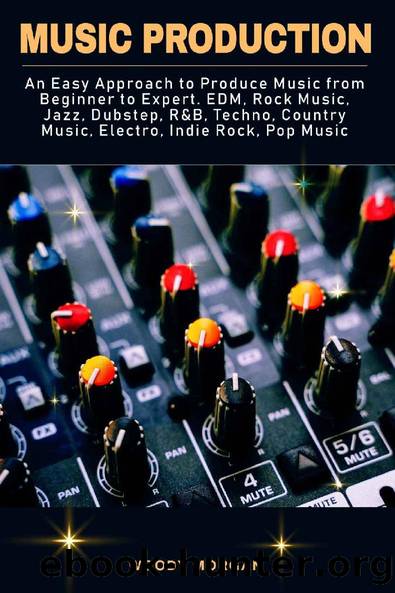Music Production: Easy Approach to Produce Music from Beginner to Expert - EDM, Rock Music, Jazz, Dubstep, Techno, Country Music, Indie Rock, Pop Music by Woody Morgan

Author:Woody Morgan [Morgan, Woody]
Language: eng
Format: epub
Tags: Ozair_Solutions at Fiverr, ebook formatting
Publisher: Ozair_solutions at Fiverr
Published: 2020-04-05T00:00:00+00:00
Compression
Compression is an apparatus we use all the time in mixing. It controls volume and turns things down when they get too loud while turning up the tranquil parts. Essentially, it decreases the dynamic range of a sound. For example, if somebody talks loudly and discreetly, a compressor will carry the levels nearer to the same volume, which makes it easier to hear. Each compressor can be different, but they will have the accompanying segments. Limit, this decides when compression happens. If you pull the edge down additional compression happens and you can see that by the meter which will show the gain decrease. It will let you know by what number of decibels the compressor is turning the signal down. To set it, pull it down until some compression happens. On certain compressors there is a knee control which sets the angle of compression. You can make it smooth for a gradual turning one of the compressor or the entire sharper for instant compression. When the signal crosses the limit, the inquiry amount is it going to turn it down. Is it going to turn it down a tad or a lot a bit? The parameter that decides is the ratio. The more we turn this up, the more the signal gets compressed. You should adhere in the 2 to 1 and 4 to 1 ratio range and then occasionally go up higher if you have to have increasingly aggressive compression. Next up are gain controls. After the signal is compressed, we need to go through make gain to recover the volume to where it was before compression so weâre hearing it at the same volume. This allows us to hear really whatâs happening. If all weâre hearing is volume difference, we will think the louder one always sounds better. The entire reason we use compression and the best way to hear that is to make sure weâve done some level matching prior and then afterward. A few compressors feature an information meter and also yield meter, which allows you to match things up visually. Besides, a few compressors have an auto gain button that will do that for you. Sometimes they function admirably, and now and then they donât. Much of the time itâs increasingly accurate and preferable to adjust manually. The final two handles that we have to pay attention to are attack and release. This has to do with how rapidly the compressor turns the signal down once it crosses the limit. Does it turn it down immediately or does it let a portion of the signal through and then turn it down? What verifies that is the attack setting. This is one of the most essential important settings you can use when compressing. If you re-ally fast on the attack at that point it will clamp down on that signal re-ally fast and it wonât let more a transient through. Sometimes, thatâs exactly what you want, and once in a while itâs not. Personally, I like to leave some attack time in there with the goal that that punch can come through.
Download
This site does not store any files on its server. We only index and link to content provided by other sites. Please contact the content providers to delete copyright contents if any and email us, we'll remove relevant links or contents immediately.
| Biographies | Business |
| History & Criticism | Instruments |
| Musical Genres | Recording & Sound |
| Reference | Songbooks |
| Theory, Composition & Performance |
The Goal (Off-Campus #4) by Elle Kennedy(12451)
Kathy Andrews Collection by Kathy Andrews(10559)
Diary of a Player by Brad Paisley(6872)
What Does This Button Do? by Bruce Dickinson(5537)
Assassin’s Fate by Robin Hobb(5256)
Big Little Lies by Liane Moriarty(4893)
Pale Blue Dot by Carl Sagan(4018)
Sticky Fingers by Joe Hagan(3459)
The Heroin Diaries by Nikki Sixx(2943)
The Death of the Heart by Elizabeth Bowen(2910)
Beneath These Shadows by Meghan March(2730)
The Help by Kathryn Stockett(2709)
Confessions of a Video Vixen by Karrine Steffans(2682)
How Music Works by David Byrne(2539)
Jam by Jam (epub)(2496)
Harry Potter 4 - Harry Potter and The Goblet of Fire by J.K.Rowling(2422)
Strange Fascination: David Bowie: The Definitive Story by David Buckley(2371)
Petty: The Biography by Warren Zanes(2241)
Darker Than the Deepest Sea by Trevor Dann(2214)
